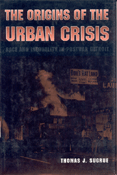
Driving While Black: The Car and Race Relations in Modern America
For Further Reading
The history of race and the automobile has yet to be written; thus the material for this article is scattered widely in many sources. The most helpful are included in the annotated bibliography below.
The controversy over racial profiling was extensively covered in daily newspapers and newsweeklies. For further reading, see David A. Harris, Profiles in Injustice: Why Racial Profiling Cannot Work (New York: The New Press, 2002); the brief but useful summary of the profiling controversy in Michael K. Brown, et al., White-Washing Race: The Myth of a Color Blind Society (Berkeley and Los Angeles: University of California Press, 2003); and the most widely quoted report on profiling: State of New Jersey, Office of the Attorney General. Selected Highlights of the Interim Report of the State Police Review Team Regarding Allegations of Racial Profiling. (Trenton: Office of the Attorney General, 1999).
For the experiences of black travelers (and for an indispensable and encyclopedic discussion of the broader context of race relations and discrimination in mid-twentieth century America), see Gunnar Myrdal, An American Dilemma: The Negro Problem and American Democracy, 2 volumes (New York: Harper Brothers, 1944). For comments on driving in the South, see Arthur Raper, Preface to Peasantry: A Tale of Two Black Belt Counties (Chapel Hill: The University of North Carolina Press, 1936). On the experience of black travelers, see Mark S. Foster, "In the Face of 'Jim Crow': Prosperous Blacks and Vacations, Travel, and Outdoor Leisure, 1890-1945," Journal of Negro History 84:2 (Spring 1999). For the autobiography of a pioneering black car dealer, see Ed Davis, One Man's Way (Detroit: Ed Davis Associates, 1979).
Two useful starting points for a discussion of the automobile in black popular culture are Suzanne E. Smith, Dancing in the Streets: Motown and the Cultural Politics of Detroit (Cambridge: Harvard University Press, 1999); and George Lipsitz, The Possessive Investment in Whiteness: How White People Profit from Identity Politics (Philadelphia: Temple University Press, 1998).
The classic article on poverty, race, and the "spatial mismatch" is John F. Kain, "Housing Segregation, Negro Employment, and Metropolitan Decentralization," Quarterly Journal of Economics 82 (May 1968), 175-97. The best overview of the scholarship on spatial mismatch, with special attention to transportation policy, is Margaret Pugh, "Barriers to Work: The Spatial Divide Between Jobs and Welfare Recipients in Metropolitan Areas," Brookings Institution, Center for Metropolitan and Urban Policy Working Paper, September 1998. For data on transportation options by race and class, see John Pucher and John L. Penne, "Socioeconomics of Urban Travel: Evidence from the 2001 NHTS," Transportation Quarterly 57:3 (Summer 2003), 49-77.
The relationship of blacks to automobile work is the subject of an extensive literature. On workplace discrimination in the motor vehicle industry, see Thomas J. Sugrue, The Origins of the Urban Crisis: Race and Inequality in Postwar Detroit (Princeton: Princeton University Press, 1996), esp. chapter 4; Thomas N. Maloney and Warren C. Whatley, "Making the Effort: The Contours of Racial Discrimination in Detroit's Labor Markets, 1920-1940," Journal of Economic History 55 (1995), 483-486; and August Meier and Elliott Rudwick, Black Detroit and the Rise of the UAW (New York: Oxford University Press, 1979). On challenges against workplace discrimination, see especially Kevin Boyle, "'There Are No Union Sorrows That the Union Can't Heal': The Struggle for Racial Equality in the United Automobile Workers, 1940-1960," Labor History 36 (Winter 1995), 5-23. For the revolutionary union movements and shopfloor radicalism among black workers in the 1960s and 1970s, see Heather Thompson, Whose Detroit? Politics, Labor, and Race in a Modern American City (Ithaca: Cornell University Press, 2001); James A. Geschwender, Class, Race, and Worker Insurgency: The League of Revolutionary Black Workers (New York: Cambridge University Press, 1977).
<<Previous Section - Next Section>>
Introduction
The Car and Jim Crow
"Drivin' Down the Freeway": Blacks and Car Culture
Image Versus Reality
On the Line: Blacks and Auto Work
For Further Reading
Complete Text Printable View
About the Project | Credits | Contact Us | Student & Teacher Resources | Site Map
©2004-2010 Automobile in American Life and Society
